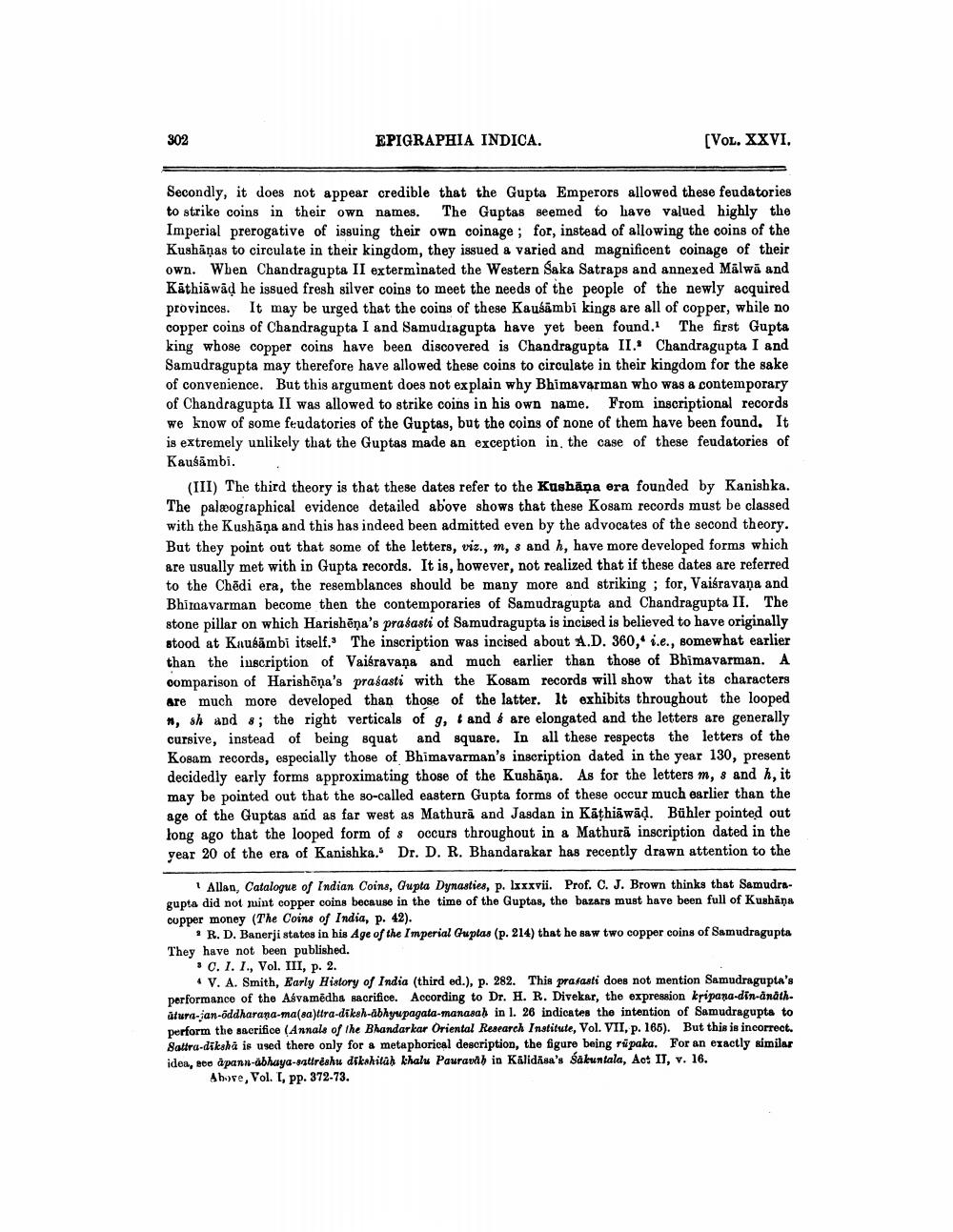________________
302
EPIGRAPHIA INDICA.
[VOL. XXVI.
Secondly, it does not appear credible that the Gupta Emperors allowed these feudatories to strike coins in their own names. The Guptas seemed to have valued highly the Imperial prerogative of issuing their own coinage; for, instead of allowing the coins of the Kushānas to circulate in their kingdom, they issued a varied and magnificent coinage of their own. When Chandragupta II exterminated the Western Saka Satraps and annexed Malwa and Kathiawaḍ he issued fresh silver coins to meet the needs of the people of the newly acquired provinces. It may be urged that the coins of these Kausambi kings are all of copper, while no copper coins of Chandragupta I and Samudragupta have yet been found. The first Gupta king whose copper coins have been discovered is Chandragupta II. Chandragupta I and Samudragupta may therefore have allowed these coins to circulate in their kingdom for the sake of convenience. But this argument does not explain why Bhimavarman who was a contemporary of Chandragupta II was allowed to strike coins in his own name. From inscriptional records we know of some feudatories of the Guptas, but the coins of none of them have been found. It is extremely unlikely that the Guptas made an exception in the case of these feudatories of Kausāmbi.
(III) The third theory is that these dates refer to the Kushana era founded by Kanishka. The palæographical evidence detailed above shows that these Kosam records must be classed with the Kushana and this has indeed been admitted even by the advocates of the second theory. But they point out that some of the letters, viz., m, s and h, have more developed forms which are usually met with in Gupta records. It is, however, not realized that if these dates are referred to the Chedi era, the resemblances should be many more and striking; for, Vaisravana and Bhimavarman become then the contemporaries of Samudragupta and Chandragupta II. The stone pillar on which Harishēņa's prasasti of Samudragupta is incised is believed to have originally stood at Kausambi itself. The inscription was incised about A.D. 360, i.e., somewhat earlier than the inscription of Vaisravana and much earlier than those of Bhimavarman. A comparison of Harishona's prasasti with the Kosam records will show that its characters are much more developed than those of the latter. It exhibits throughout the looped n, sh and s; the right verticals of g, t and are elongated and the letters are generally cursive, instead of being squat and square. In all these respects the letters of the Kosam records, especially those of Bhimavarman's inscription dated in the year 130, present decidedly early forms approximating those of the Kushana. As for the letters m, s and h, it may be pointed out that the so-called eastern Gupta forms of these occur much earlier than the age of the Guptas and as far west as Mathura and Jasdan in Kathiawaḍ. Bühler pointed out long ago that the looped form of s occurs throughout in a Mathura inscription dated in the year 20 of the era of Kanishka. Dr. D. R. Bhandarakar has recently drawn attention to the
Allan, Catalogue of Indian Coins, Gupta Dynasties, p. lxxxvii. Prof. C. J. Brown thinks that Samudragupta did not mint copper coins because in the time of the Guptas, the bazars must have been full of Kushana copper money (The Coins of India, p. 42).
2 R. D. Banerji states in his Age of the Imperial Guptas (p. 214) that he saw two copper coins of Samudragupta They have not been published.
3 C. I. I., Vol. III, p. 2.
4 V. A. Smith, Early History of India (third ed.), p. 282. This prasasti does not mention Samudragupta's performance of the Aévamedha sacrifice. According to Dr. H. R. Divekar, the expression kripana-din-änäthatura-jan-öddharana-ma(sa)ttra-dikeh-äbhyupagata-manasah in 1. 26 indicates the intention of Samudragupta to perform the sacrifice (Annals of the Bhandarkar Oriental Research Institute, Vol. VII, p. 165). But this is incorrect. Sattra-diksha is used there only for a metaphorical description, the figure being rupaka. For an exactly similar idea, see àpann-abhaya-sattrèshu dikshitah khalu Pauravah in Kalidasa's Sakuntala, Act II, v. 16.
Above, Vol. I, pp. 372-73.




